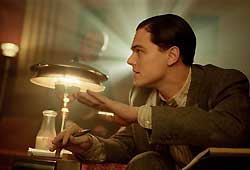|
||||||||||||||||||
| USA, 2004 directed by Martin Scorsese, starring Leonardo Di Caprio, Cate Blanchett, Kate Beckinsale, John C. Reilly, Alec Baldwin, Alan Alda, Ian Holm, Jude Law, Gwen Stefani Watching The Aviator, we can understand how much Gangs of New York represented an important turning point in Martin Scorsese’s movies; a two-way headed turning point: towards a production greatness even his high-budget movies weren't concieved with; and towards a widening of his point of view to a more global vision of American History. Surely, Scorsese’s movies never lacked the above-mentioned elements, mainly a critical view of America that can be found in all of his movies (from Boxcar Bertha to Casino); however both of these elements are now part of a wider view. It seems that what the director has lost in terms of form, representation and visual rendering, was indeed reshaped into projects that are less sharp and solid, but more ambitious, complex and heterogeneous: on the whole Scorsese’s filmmaking seems to have now a more monumental and definitive, almost preachifying attitude. A giant against America As already stressed in several occasions, the relationship between the individual and its belonging group, with all the tensions the situation creates, is the topic that constantly characterized Scorsese’s work, either when speaking about the Mafia or when analyzing aristocracy from the beginning of the twentieth century: the nature of social relationships has been the object of a very sharp analysis that, often starting from a simple lab experiment, progressively expanded to wider considerations. In the Aviator the dramatic strategy that mapped out the route from “story” to “History” is eluded since “History” is faced directly, since the point of view becomes magniloquent and totalizing. That's when Howard Huges steps in. The record-man in economics, sports, motion pictures, love affairs; the giant the story needs in order to play an even match with History. At the age of 18 he is already an orphan, and let alone in the family's assets administration: even his obsessive-compulsory behaving, that will increase more and more in time, excluding him from social life, is symptom-consequence of the man's great isolation, a man that's perfect as the main character in the struggle Scorsese chooses to represent. Huges is alone against America, and he is among the few that can afford a conflict at this level. If it was easy to read the history of American capitalism and politics between the lines of the likes of Goodfellas and Casino, The Aviator brings both of these elements back as direct opponents; Scorsese's main characters' struggle to affirm their personality inevitably clashes with the ancient walls of the established social order; in The Aviator Huges fights without pauses against the shackles of a whole country: a bare-hands fight against its hypocrisy, prejudices, corruption. We can see the fights against the corporations to keep the TWA control, against senator Owen Brewster, who brings him to court to help competitors, the battle to overcome the technical limits of the time, but also the ethic limits, by showing Janes Russel’s breast, a young debutant-actress, in The Outlaw. The Aviator first sequence contains in itself story's main theme, the way only great filmmakers manage to achieve. In a silent and barely chimney-illuminated room, Huges' mother gives him a bath while teaching the boy the word “quarantine”, warning him against a very close epidemic: the main character’s loneliness and his privileged condition are exemplarily told, simply summarized in the word “quarantine”. Huges won’t be able to isolate the rest of the world to protect himself from its infection, but he’ll have to isolate himself, and he will have to fight to gain isolation. Justified compromises The Aviator's importance in Scorsese's filmography and its turning-point status deals not only with narrative emphasis, but also, as mentioned above, with a new productive magniloquence - and all that this implies. Two new, important elements make their appearance in his movies: Hollywood's world, that Scorsese portrays for the first time, showing its behind-the-scenes, its sadness, its greatness; and the digital technology, often used not only as a fix to render seamlessly the heavy special effects, but also as a photography choice. If it is true that it was impossible to narrate Huges’ biography without widely showing the 30s and 40s movies industry, however it must be pointed out that the very moment Scorsese fully adopts a “bigger than life" philosophy, Hollywood shows up in his movies, bringing the contradictions of being a world of his own, made of unlimited moralism and excess, prosperity and poverty. Huges feels uncomfortable in this world: he cannot follow its rules due to ingenuity, or arrogance, and the only possible relationship is represented by a new challenge: shooting the most expensive movie of history, fighting against censorship, getting in and out love stories with the most beautiful divas of the time. Obviously Scorsese is very different from his main character: compromise with a Major Studio’s needs is brought on with class and cunning, even in allowing (assuming it was allowance) the use of digital technology, giving up by these means the cinefile integrity that led him, among many others acts, to battle against Kodak's Eastman colors flaws related to film aging. In The Aviator, the digital format often reaches a not-so-good render of inside shots: the visual issue thus exposed is just the most blatant sign of the many compromises in storytelling and shooting directly imposed from a mainstream Studio's will. Compromises that give to The Aviator the blockbuster appeal needed to reach the production turning point the director was looking for. The bet is risky, but the challenge of taking off and landing such a huge movie in the end looks like Huges’ challenge to fly the biggest aircraft of the world: the Hercules. History will tell both of them were right. |
||||||||||||||||||

